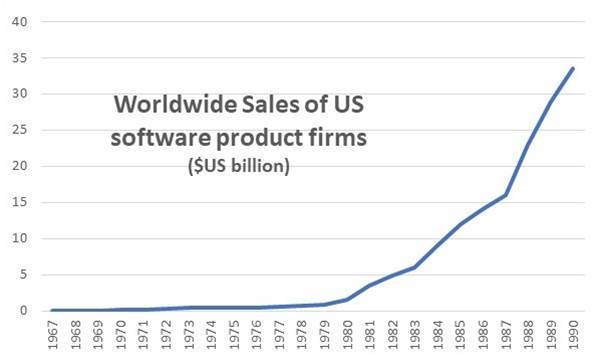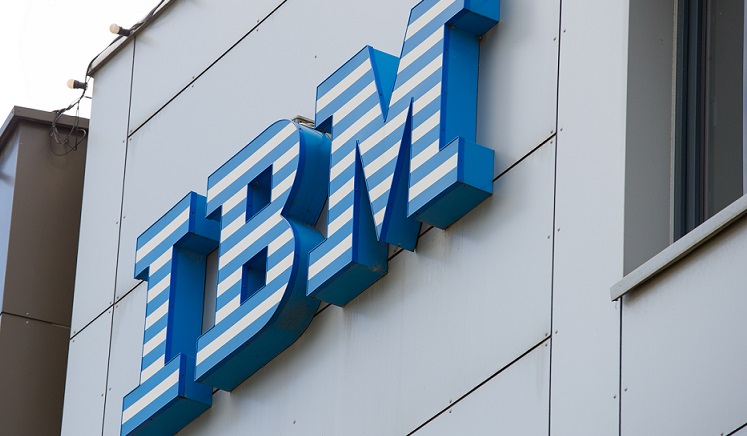Preamble
The Australian Computer Society (ACS) was formed 50 years ago, when the various state computer societies joined forces.
To mark the occasion, the ACS has initiated a heritage project to honour the many individuals who have contributed to the growth of the ICT profession in Australia.
At the heart of the project is a history of computing in Australia. It is not just a history of the ACS, but the history of a profession.
Australia has the longest computing history of any country, excepting the US and the UK, and CSIRAC in the Museum of Victoria is the oldest computer still in existence.
Chapter 32: Multinational software companies move in
After IBM’s momentous decision in 1969 to unbundle its software from its hardware, the software industry in the USA and globally expanded rapidly (see Chapter 24). There were two reasons for this. The first was that people now had a choice, and could buy software from other sources, rather than being tied to the hardware vendor.
The second, which was equally important, was that IBM’s operating systems and other aspects of the system software were limited in their functionality. Smart developers were able to develop products that enhanced the operation of IBM mainframes, and saved their users money through the increased efficiencies. Most of the new system software companies that grew up during this time were founded on a single product that made IBM mainframes faster, easier or less expensive to use.
Australia was a major player in this market. Some of the most successful independent software products selling into the IBM systems software space were designed in Australia.
Over time, IBM incorporated most of these functional enhancements into its own operating systems, or developed equivalent add-on products. This meant that most of the system software companies that grew up in the 1970s and 1980s eventually disappeared, mostly through acquisition – and most of them acquired by one company, Computer Associates (see below).
Most of these companies established offices in Australia in the 1970s. In most cases their products were initially handled by distributors, but most of them had set up direct subsidiaries by the end of the 1980s, which was a booming decade for software, with the global market growing exponentially (see chart below).

International software companies that set up in Australia during this period, either directly or through distributors, included:
Applied Data Research (ADR)
ADR was the first independent software company, founded in Princeton, New Jersey in 1959 as a contract programming company. It was one of the few software companies to be successful with packaged software before IBM’s unbundling decision in 1969, with its Autoflow flowcharting package.
ADR was best known for its Datacom/DB database management system, one of the first database products. Datacom/DB was introduced by a small Dallas-based company called Computer Information Management, founded by three ex-IBMers, in 1971, then acquired by another small software company called Insyte shortly afterwards. Insyte sold Datacom/DB to ADR in 1978.
ADR set up an Australian subsidiary in 1984, under Kevin Nuttall, but it was short-lived as ADR was acquired by Computer Associates (see below) in 1986. Datacom/DB, now called CA Datacom, is still widely used today, in Australia and globally. (Datacom is not to be confused with the large New Zealand-based software and services company of the same name, which also operates in Australia).
BMC
BMC was founded in Houston Texas in 1980 by three former Shell Oil employees. Its IBM mainframe utilities became very popular, and the company went public in 1988, the year it opened a subsidiary in Australia.
It grew strongly through acquisition and organic growth in the 1990s, and was one of the few companies in the IBM mainframe utilities market not to be acquired by Computer Associates.
Cincom
Like ADR, Cincom was also founded before the software unbundling decision. It was started in Cincinnati, Ohio in 1968 by Tom Nies, a former IBM salesman, and two associates (Cincom is a contraction of ‘Cincinnati Computer’). Neis is still CEO today, making him the longest-serving CEO in the global computer industry.
Cincom’s first product, and its mainstay ever since, is its Total database management system. It expanded into application software in the manufacturing industry, and built 4GLs such as Mantis and Supra. It has always remained privately owned.
Cincom entered the Australian market in 1974, with direct representation from an office in Sydney under Ian MacLachlan. Early users of Total were Caltex, T&G Insurance and Aftek, a service company for building societies. Total was very successful across many hardware platforms and made Cincom one of the leading multinational software companies in Australia in the 1980s and 1990s. MacLachlan left soon after it started and was replaced by Barry Sargeant, who was succeeded by John Debrincat in 1979.
Computer Associates
Computer Associates, usually known as CA, was one of the most important independent software vendors (it still is today and called CA Technologies). In New York in 1976, Charles (‘Charlie’) Wang, a Taiwanese immigrant was working in a Manhattan computer services bureau that marketed software from a small Swiss company called Computer Associates. Its main product was a sorting and data management utility for IBM mainframes called CA-Sort.
Wang saw an opportunity to start a new business to sell the product in the USA in a joint venture with the Swiss company. The American operation was initially called Trans-American Computer Associates. Wang could not afford a conventional marketing campaign and decided to sell CA-Sort by telephone and through mail order on a ‘try before you buy’ basis for $3000. It was a sales technique and a pricing level unheard of in the industry at the time. It made CA-Sort so successful that Wang was able to buy the Swiss company in 1980 and take Computer Associates public in 1981.
Wang (pronounced ‘Wong’) became one of the leading figures in the global computer industry in the 1970s and 1980s, well known for his aggressive and innovative marketing practices. In 1989, CA became the first software company to reach US$1 billion in revenues. In the late 1980s and the 1990s, Computer Associates gained a reputation for hostile and opportunistic acquisition, which led to extremely adverse press coverage.
CA-Sort was initially distributed in Australia by Carus Pacific, which also distributed software from Pansophic Systems (see below) and Software International. A direct subsidiary was set up in Australia in 1977 after the Swiss arm of Computer Associates bought Carus. Alan Gallagher, who had worked for Carus, was the first managing director, replaced by Swiss Jorg Illi in 1979, though there were still only three staff. Illi was replaced by David Wardle in 1987.
After the local company consolidated around Wang’s US operation in 1980, Computer Associates Australia grew quickly and became one of the largest software companies in Australia, mirroring the growth of the organisation in the US and globally.
Computer Corporation of America
CCA was founded in Massachusetts in 1965 to develop a high-performance database management system for the US National Security Agency (NSA). The software became Model 204, a ‘multi-value’ database with a built-in programming and application development environment.
The multi-value data model, which allows for multi-dimensional tables, was first developed in the early 1960s by Don Nelson and Dick Pick, programmers at giant US defence contractor TRW. Dick Pick subsequently used the concept for his Pick operating environment, which was very popular in Australia (see Chapter 27).
Model 204 is capable of storing vast amounts of data and of handling very high transaction loads. It was very popular in the US Defense Department, and is particularly important in Australia because of the sale of the product to the Department of Social Security (DSS) in 1983, by Computer Power’s product division, as part of the STRATPLAN re-equipment project. Computer Power also made other Model 204 sales in Australia, most notably to Telecom and the Department of Defence.
All those systems were subsequently replaced by relational databases, with the exception of DSS, which still uses Model 204 to run Centrelink’s payments system today. It is one of the largest Model 204 implementations in the world. Even after Computer Power stopped distributing the software in Australia, CCA never set up a local office, flying in staff from Massachusetts as necessary.
The replacement of Model 204 at Centrelink has been suggested for more than a decade, but the size and the cost of the systems redevelopment project has seen the idea repeatedly postponed.
CCA was acquired in 2010 by Boston-based Rocket Software, an IBM strategic partner. Model 204 is now called Rocket M204.
Next week, we look at Compuware, Cullinet, Goal Systems, Legent, Pansophic, SAS Institute and Software AG.
Veteran ICT journalist Graeme Philipson is researching and writing the Heritage Project book, which is due for release on the 50th anniversary of the formal incorporation of the ACS, on 3 October 2017.
The project also involves the creation of a ‘virtual museum’, cataloguing hardware and other artefacts, and collecting and curating documents on the history of the industry, including oral histories of as many people as possible.
Please get in touch with Graeme if you would like to contribute, at [email protected]
Do you have early memories of the ICT industry in Australia? Help us make history by sending us your story! Record or write your memories to be included in our historic ACS Heritage Project. Details here.
Previously published:
Chapter 31: Birth of Australian software and services industry
Chapter 30: The rise and decline of the PCMs
Chapter 29: ‘Plug compatible manufacturers’ take on IBM
Chapter 28: The rise of Fujitsu
Chapter 26: The rest of the BUNCH
Chapter 25: Honeywell in Australia
Chapter 23: ACS at home and abroad
Chapter 22: The early years of the Australian Computer Society
Chapter 21: Other Australian universities
Chapter 20: University of Melbourne and Monash
Chapter 19: Sydney University and UNSW lead the way
Chapter 18: Computing in the Australian Government
Chapter 17: Trevor Pearcey and the birth of CSIRONET
Chapter 16: Enter the minicomputer – DEC comes to Australia
Chapter 15: The IBM S/360 in Australia
Chapter 14: IBM redefines the computer industry
Chapter 13: Control Data Australia (part II)
Chapter 12: Control Data Australia (part I)
Chapter 11: The Australian Computer Society
Chapter 10: Five Computer Societies
Chapter 9: Australian made, Australian designed
Chapter 8: Australia's Computer Industry in 1962
Chapter 5: SILLIAC and the Snowy Mountains Scheme
Chapter 3: Harry Messel and the birth of SILLIAC










